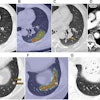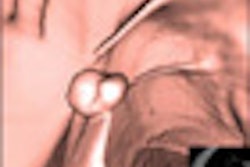CHICAGO - Older patients undergoing virtual colonoscopy (also known as CT colonography or CTC) do not require significantly more follow-up imaging than younger screening patients, concludes a new study from New York University (NYU) School of Medicine in New York City.
The report, presented at the 2010 RSNA meeting, is the latest in a series of studies demonstrating that older VC screening patients are similar in many respects to traditional VC screening patients ages 50 and older. The subject of CTC outcomes in older patients is an important one for the U.S. government as it weighs the utility of CTC screening versus other recommended colorectal cancer screening methods.
When the U.S. Centers for Medicare and Medicaid Services (CMS) denied routine reimbursement for virtual colonoscopy screening in May 2009, one of the agency's chief concerns was that VC screening in its main patient group -- individuals 65 years and older -- would lead to the discovery of significant pathology, both intra- and extracolonic. This, in turn, would lead to additional testing and ultimately render the VC scans riskier and more expensive to deliver than other screening methods. As a result, the finding that few additional imaging exams are generated by VC screening in older patients in this cohort can be viewed as validation of the technique by VC proponents.
"Recommendations for additional imaging in radiology, in general, has become an emerging topic," said Gregory Nevsky, MD, from NYU, in his presentation, citing a large study that found a doubling in requests for additional imaging (RAI) between 1995 and 2008. In virtual colonoscopy specifically, C-RADS E3 and E4 findings, accorded to extracolonic findings such as aneurysms and lymphadenopathy that are potentially clinically significant, often generate RAI to rule out serious pathology, leading to reported increases in the cost of VC exams of between $25 and $30 per patient when spread out among all screening patients.
Most extracolonic findings are clinically insignificant E1 and E2 findings, so their overall prevalence is less important than the number of potentially serious extracolonic findings classified as E3 or E4, Nevsky said.
However, a central question -- whether older patients generate more RAI than younger individuals -- has not been studied extensively, though the answer will be critical in future screening policy decisions, as CMS decides whether to reverse its denial of coverage. Previous studies have suggested requests for additional imaging in 4% to 7% of screening patients.
In their study, Nevsky and his colleagues from NYU, including Michael Macari, MD, and Alec Megibow, MD, aimed to determine the frequency of RAI in older patients by reviewing the institution's records of 454 patients who underwent low-dose (< 50 mAs) VC screening between 2005 and 2008. The cohort was divided into two groups:
- 204 non-Medicare-aged patients (mean age, 52 years; range, 50-64). Of these, 112 were screening patients, and 92 were referred to VC after incomplete colonoscopy due to pain, tortuous colon, or diverticular disease.
- 250 Medicare-eligible patients (mean age, 69 years; range, 65-74). Of these 82 were asymptomatic screening patients, and 168 were referred to VC after incomplete colonoscopy due to pain, tortuous colon, or diverticular disease.
"The records were read retrospectively by a single radiologist experienced in CTC interpretation, and the dictated reports were analyzed to determine the frequency rate of extracolonic findings and the number of times additional imaging was suggested," Nevsky said.
A Fisher's exact test was used to compare the percentage of Medicare and non-Medicare patients with at least one reported extracolonic finding and the frequency of recommendations for additional imaging. A retrospectively applied C-RADS score for each extracolonic finding and current Medicare reimbursement rates were used to estimate the cost of care associated with recommendations for additional imaging.
"We found that in the Medicare group, there was a statistically significant higher number of extracolonic findings at 74% of the studies compared to 55% in the non-Medicare cohort," Nevsky said. "However, the recommendations for additional imaging in these studies were not significantly different at 6% in the Medicare group and 4.4% in the non-Medicare group. And the indication for referral for virtual colonoscopy did not significantly influence the rate of extracolonic findings or the recommendations for additional imaging."
Extracolonic findings and RAI in Medicare versus non-Medicare subjects
|
The clinical indication for CTC (screening versus incomplete colonoscopy) did not have a significant influence on the likelihood of an extracolonic finding being detected (p = 0.769) or the likelihood of RAI being suggested (p = 0.520) Nevsky said.
The most common indication for recommended additional imaging was CT for gastrointestinal stromal tumor (GIST), which was recommended in seven of 24 Medicare patients who received RAI, followed by ultrasound of the pelvis in six patients with suspected adnexal masses, he said. All 24 patients recommended for additional imaging had E4 findings indicating potential clinical significance.
The costs of follow-up were calculated to be slightly lower than those of previous studies, Nevsky said.
Cost if every RAI were followed
|
In comparison, a 2008 study by Pickhardt and colleagues of 2,195 adults undergoing screening found a 7% RAI. In 2000, Hara et al studied 264 screening subjects, of whom 7% were recommended for additional imaging. "So our numbers are smaller," Nevsky said.
The main limitation of the study was its retrospective nature; in addition, the actual patient outcomes are unknown, he said. "This is due to ours being a referral center, and a lot of our patients are treated elsewhere," he said.
"Among a group of trained abdominal radiologists, the recommendations for additional imaging are exceedingly low among both Medicare and non-Medicare patients, and [they are] not influenced by the clinical indication of the study," Nevsky concluded.
"This study on extracolonic findings is huge in terms of reimbursement," commented session moderator Elizabeth McFarland, MD, from the Center for Diagnostic Imaging in St. Louis. "We know that the U.S. Preventive Services Task Force had given CTC an 'I' for indeterminate status in part because of concerns for the extra costs of extracolonic findings, so it's a really significant paper. It's also nice to see [use of] the C-RADS system -- that way you can be sure you're comparing apples to apples" in the categorization of extracolonic findings, she said.
By Eric Barnes
AuntMinnie.com staff writer
December 1, 2010
Related Reading
VC advocates tout aggressive strategy for screening coverage, October 26, 2010
Study: VC improves colon screening rates, October 21, 2010
Higher colonoscopy complication rates found in seniors, October 19, 2010
ACG to Obama: Colonoscopy better than virtual exam, March 4, 2010
VC screening maintains performance in Medicare population, November 9, 2009
Copyright © 2010 AuntMinnie.com




















